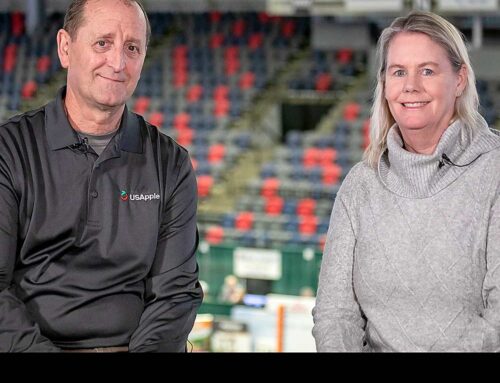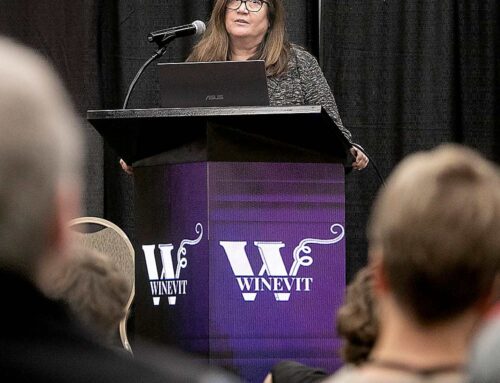1
We understand your risks and challenges. Mast said marketers understand the huge risks that growers take when planting orchards. Increasing production costs and retailers’ food safety requirements are just adding to the challenges.
“We want to make sure that small family farmers stay in existence,” he said. “If there are too many requirements, they aren’t going to make it. We’re trying to do a good job of educating the retailers on what it takes to get product from farm to fork.”
Mast said marketers like to bring retailers out to Washington State and tour them through orchards and packing houses to show them all the inputs and costs that go into getting product from the tree to the shelf.
“It’s beneficial when they can see all the nuances and the science that goes into getting a piece of fruit of the size range they want and the color they like. Once they realize all the inputs and all the costs that go into farming, they tend to be a little more understanding when you’re trying to hold your ground on f.o.b.s. (prices).”
Marketers also try to discourage buyers from making demands that add to growers’ food-safety audit fatigue.
“We’re really trying to work with the retailers and bring in some common sense, and temper the massive amount of requests that are coming at the growers,” Mast said. “We fight the good fight for the growers.”
2
The market is only interested in flavor and crunch. A few years ago when Mast and his partners were planting an orchard, they debated the pros and cons of planting Honeycrisp versus Jonagold. They went with the latter because it’s a grower-friendly variety that gets good packouts, making it less risky—in theory.
“The thing we overlooked is what piqued the consumers’ interest,” Mast said, listing Jonagold, Braeburn, and Cameo as varieties that are becoming harder to sell. “They were absolutely beautiful apples, but it’s a shrinking market.”
Consumers are recognizing that apples don’t have to look beautiful and are willing to pay dearly for fruit that has good taste and texture.
“You have heirloom tomatoes that don’t look the best, but they have good flavor,” Mast said. “It’s really about the flavor and crunch factor, and that’s what got Honeycrisp on the map. It was not the beauty of the apple.”
Early this season, Honeycrisp was selling for more than $80 a box, f.o.b.
“Every marketer in the industry loves Honeycrisp because it’s definitely broken the glass ceiling of what consumers are willing to pay for a good eating experience,” he added. “It’s given retailers an increased confidence level in the prices they can charge for good products.”
And that, he said, seems to have lifted the perceived value of the entire apple category.
“We’ve tried to educate our retailers that the elasticity of pricing is stronger than what we once thought it was, based on what they are willing to pay for Honeycrisp. It’s really paved the way for getting rid of the thought process that apples have to be dirt cheap before consumers are going to pick them up.”
3
We can’t hold out forever for fixed prices. Increasing production in Washington State as well as a shift in the Midwest and eastern growing regions from the processing sector to the fresh market are changing market forces.
“What’s worked in the past, I don’t believe will work in the future as we move into larger crops,” Mast said.
The open market or spot markets used to be viable options.
“Going forward, I think those markets are going to be a bit more of a challenge, so I think it’s going to be very important to have relationships with the retailers you work with. The ability to achieve the maximum f.o.b. going forward is going to come from the program business and not playing the spot markets as in the past.”
Although marketers work out advanced commitments for fruit with their retail customers, some flexibility must be built into the agreements, he said.
“Typically, when we set up an agreed-upon price, we’ve got an understanding with the retailer that if the market goes up we have the ability to go up, and if it goes down, we have to move with the market as well,” he said. “You have to be flexible and work with the retailer for the long-term interests of both parties. You can hold your line with the retailer and maintain that price for the committed time frame, but that doesn’t mean that the next time pricing comes out, they will stick with you. They may go shop around.”
4
We are trying to maximize your returns. The produce department is an increasingly crowded environment with limited shelf space.
“You used to have 300 to 400 items in the produce department, and now you have 1,000 to 1,200 items,” Mast said.
One way CMI tries to expand the display space for apples is by offering retailers an easy-to-assemble, freestanding secondary display that holds two boxes of apples and can be located outside the produce department.
This season, the company introduced colorful pouch bags that contain two pounds of small apples or pears. Packaging the fruit this way makes hard-to-sell sizes (113 and smaller apples) into a product that sells for perhaps a 50 percent premium over bulk prices.
Some growers might think that marketers are putting an inordinate amount of effort into promoting novel items or new varieties at the expense of the mainline varieties, Mast acknowledged. But he thinks such promotions bring excitement to the entire apple category and help increase its overall value.
“We’re always trying to find ways to extract the maximum return to the grower,” he said.
5
We put the growers first. Mast said no good marketing organization would put company-grown fruit ahead of fruit from its individual growers. Fruit is sold according to its attributes in a manner that will derive the maximum benefit for the grower, he said. “It doesn’t do us any good to export cherries that aren’t going to make the trip across the water. We try to ensure that we get the fruit to the best possible marketplace to achieve the maximum value for that fruit.
“There’s not a savvy marketer out there that doesn’t understand that we exist because of the growers, and it all starts with the growers trusting us to market their products,” he added. “If they weren’t taking the risk at the orchard level and growing the fruit, we would not have a job, so we do feel a very big responsibility to try to extract as much value to the land for the grower as we can.
“We recognize it’s their livelihood. It’s the growers who take that risk and are out there at 2 a.m. turning on wind machines so they have frost protection, and who make all the sacrifices on a daily basis to bring us a crop of fruit to market.” •






Leave A Comment